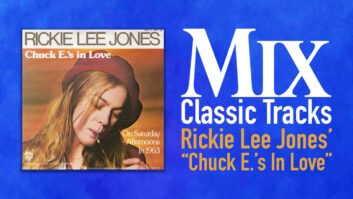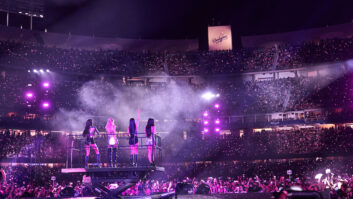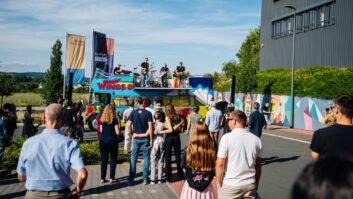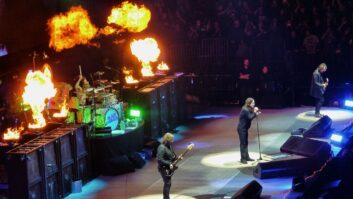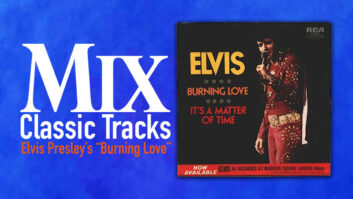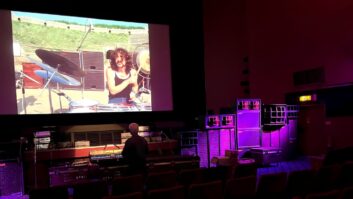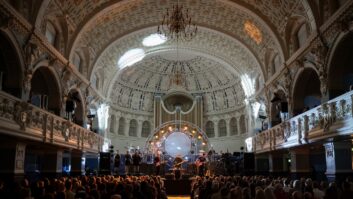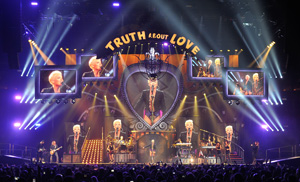
Pink’s The Truth About Love Tour visited the Oracle Arena in Oakland, Calif., in October 2013
Photo: Steve Jennings
Pink is currently embarked on the final 2013 leg of her marathon sold-out “The Truth About Love Tour,” which this year alone has taken her all over the U.S. (hitting some cities twice), Europe and Australia. The extravaganza, some of which has a hip circus vibe, features a five-piece band, two backing singers, seven dancers and very complex production involving multiple screens, glittering sets, wardrobe changes, choreographed dance routines, a small B-stage for acoustic numbers and plenty of aerial excitement which finds Pink somehow—miraculously—singing while hurtling on bungees, turning on a orb cage, somersaulting through space over the crowd and even suspended upside down. Madonna, Lady Gaga and Katy Perry have got nothin’ on Pink!
The sound gear the tour has been hauling around the world was furnished by JPJ Audio of Sydney, Australia, and is dominated by an L-Acoustics K1 system, which the tour’s original FOH engineer, Chris Madden, first encountered on Pink’s 2010 European tour. (L-Acoustics is a French company.) Each side of the main arrays comprise 14 large-format K1 loudspeakers (each containing two 15-inch woofers, four 6.5-inch cone drivers and three 3-inch compression drivers) and six of the smaller KARA loudspeakers, used for downfill. Another half-dozen KARA speakers hang in a small array between the two sides, to cover front audience, and more are placed below the main stage in front, again to cover as much of the front audience as possible. The back array is also KARAs. Aiding side coverage are arrays of multiple KUDO speakers. Additionally, for low frequency reinforcement, each side of the main arrays is augmented by eight K1-SBs, and dozens of SB-28s placed around stage level and under the ramps leading to the stage. Driving the system are eight-dozen LA8 amplified controllers.

From left: Horst Hartmann and Jon Lewis (monitors), Dave Bracey (FOH), and Ulf Oeckel (system tech)
Photo: Steve Jennings
“I think the system is absolutely superb,” comments FOH mixer Dave Bracey, who replaced Madden for the final 10-week stretch in the U.S. and Canada this fall. “The System Tech, Ulf Oeckel, is one of the best I’ve ever worked with. He’s doing a great job facilitating my mix to the P.A., so what’s coming out of the board is accurate. I’m finding it very easy to mix through the P.A.”
Though Bracey, who is based in Bristol, England, has enjoyed a long and impressive career mixing FOH for the likes of The Cure, Robbie Williams, Massive Attack and Bjork, he admits to some trepidation about coming onboard such a large-scale tour in mid-stream. “It should be daunting,” he comments, “but I had some prep time at home. DiGiCo sent an SD7 to my house and I had multitracks of the show, as well as the first edit of the DVD they shot in Melbourne, so I probably spent about 10 days familiarizing myself. I needed to do that because there were going to be no production rehearsals, it’s a complicated show, and the rest of them are up to tour speed. There was no time for me to get in that deep investigative work you normally do during production rehearsals. I had to come in at a high standard.”

Pink’s The Truth About Love Tour visited the Oracle Arena in Oakland, Calif., in October 2013
Photo: Steve Jennings
Bracey has been mixing on SD7s for the past five years, and was delighted the Pink tour allowed him to use that board, rather than the one his predecessor carried. During his prep period, “I dialed the console in, set presets for the songs, set effects, got sounds and tried to discover what works in what song and what might cause a problem during the course of the show. I was very happy sitting there at home with my Focal headphones on, wondering and hoping how well I could morph this into a live show integrated through a live P.A. system.”
When Bracey and I spoke, just three shows into the late fall tour, he admitted he was still learning the ropes to an extent, and that Pink was still adapting to his mixing style. “I have a habit of not watching the show when I mix,” he says, “but I do have a video feed going into the little screen on my console, so it’s always in my field of vision, which is good for some of the walking-offstage cues and disappearing-down-through-trap-doors cues, which weren’t exactly obvious. I didn’t get any of those wrong last night; the first night I did. Three shows in, and I’m very happy.”
And although the mixer says he has brought some outboard effects, “at the moment I’m pleased to be all internal.” He notes that his reverb moves are pre-programmed and automated.
Pity the poor monitor mixer who has to not only handle the live band, singers and dancers, but has a lead singer who is almost constantly in motion—above the stage and on it—and regularly switches between a handheld mic and a headset. Actually, it used to be a single monitor mixer—Horst Hartmann, who’s been on the last couple of Pink tours. But beginning last April, a second monitor engineer—another Brit, named Jon Lewis, who has worked with everyone from AD/DC to Paul McCartney—came on board just to handle Pink’s needs during the course of the show. Hartmann, who worked for years with The Scorpions and others in native Germany, now handles monitoring for Pink’s band and dancers, and he was also instrumental in setting up the Pink’s monitor setup.
For a console, Hartmann says, “I started with a good old [Yamaha] PM1D, because I still like it and it does the job, and because it has enough outputs—a lot of these modern consoles have enough inputs, but not really enough outputs. After we decided to have two monitor engineers, we just added another surface to it, and I had two DSP systems anyway—one was a redundant system—so now we’re using it like two consoles, but we share the inputs.” About 70 are used for the band alone, plus talkback/comm mics and a few discreet Pro Tools tracks, so there are about 100 inputs total.

Pink’s The Truth About Love Tour visited the Oracle Arena in Oakland, Calif., in October 2013
Photo: Steve Jennings
“I still know how to use an analog console,” he adds with a laugh, “so I’m actually able to push faders and press buttons, old school, which I do on the Yamaha, because it doesn’t really give you the tools to program a whole show. You can program scenes, but not a whole show. So I run the show manually more or less, like an analog console. Still, I do like to have everything saved so when I do something wrong I can go back to my favorite mix.”
The entire band—guitar, bass, drums, keys and a combo keys/guitar player/singer—is on Jerry Harvey JH16 in-ears, while the dancers use wedges (Clair 12AMs) and sidefill as they gallivant about the stage. Jon Lewis says of Pink, “Everybody thinks her vocals have to be on track [i.e. prerecorded], that she couldn’t possibly sing while she’s being catapulted around, but she sings every note, every word. It’s very impressive to have that lung capacity while you’re being thrown about or dancing nonstop.”

Photo: Steve Jennings
Pink’s main handheld mic is a Sennheiser 2000 Series with a custom “Rockheiser” 5235 capsule. Her headset features a detachable supercardioid Sennheiser mic and a connecting prototype custom ear-piece which, unlike Harveys, has a single driver, which Lewis says is “less fatiguing to over long periods of time, and still sounds really good.
“Because of the locations she is during the show—whether it’s in the air, on a B-stage or bungee’d or running around or tumbling—she won’t wear two in-ears,” Lewis adds. “It’s one-in and one-out and then wedges around to give her more of a vibe—she doesn’t like the isolation of a two-ear mix.” There are a couple of high-flying exceptions where she does don a second in-ear.
All in all it’s a lot for Lewis to manage—he sends his own reverbs and vocal effects to Pink’s in-ear—and for Bracey to keep track of at FOH.
But after nearly a full year on the road, even with changing audio personnel, Pink’s tour is still running like a finely tuned machine. Don’t be surprised if this phenomenally successful show manages to carry over into 2014, too.
